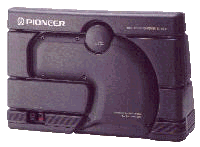Feature - N.I.F.E's
Guide to Performance Sound
by Byron R. Daugherty
HTML by Oliver Scholz
The problem driving around with
the sunroof off and the windows open is that you can't hear the radio at highway speeds.
Oh sure, you can hear some of the beat, but you would be hard pressed to tell exactly what
song is playing. It's not hard, nor overly expensive to upgrade the sound system in your
Fiero. It just depends on how much money and time you want to put into the project.
Phase I - Speaker
replacement
|
|
- By far the largest gain per dollar
will be simply replacing those awful factory speakers. If you've got more than 30,000
miles on your Fiero, and use the stereo a lot, it's a good chance those paper cone
speakers have lost over 60% of their bass response. Not to mention the fact that even new
these speakers sound muddy.
Clarity and frequency response, as well as better bass response,
will result with new speakers. Simply putting 3-way (Woofer, Mid-Range and Tweeter)
Pioneer 4x10's in front and Advent 2-way (Woofer and Tweeter) 4x6's in back, I could now
hear the detail and the vocals of the music on the radio, no other change was made. The
difference is like night and day!
Here are some examples of
speakers:
Front:
- Pioneer TS-A4105 3-way, 2-35W RMS,
$120
- Pioneer TS-4103 2-way, 2-35W RMS,
$100
- Kenwood KFC-411G 2-way, 2-35W RMS,
$100
Rear:
- Jensen JFX-1246, $20
- Pioneer TS-4603, $70
- Pioneer TS-4602, $60
- Pioneer TS-A4605, $100
- Pioneer TS-P461, $130
- Infinity RS-4602, $80
- Infinity 46P, $80, High power
needed!
- Infinity Kappa 462P, $150, High
power needed!
- Advent 4.6i $80
- Polk EX462, $80
- Kenwood KFC-463V, $70
- Kenwood KFC-HQ460, $130, High
power needed!
- Sony XS-PL46, $100, High power
needed!
|
Phase II: Bass
Enhancement
|
|
- Now you can hear more of your
music than ever. But you're still missing out on the full spectrum. A subwoofer can
drastically improve the bass of your system.
There are two ways to get a subwoofer in your Fiero: find a Fiero
equipped with a factory subwoofer, or install an aftermarket unit.
I've seen some interesting
installations. One was a SAS Bazooka Tube (a subwoofer in a long, round case) velcroed to
the passenger side of the center console. Not very subtle. Another is in member Tim Hill's
car. He built a custom enclosure with matching carpeting that takes up the left front of
the passenger foot compartment. More subtle, but can be a problem with 9 inch stilettos.

Fortunately, in response to the
current rash of small pickups, Pioneer has responded with a subwoofer box (the X-30) that
can fit behind your seat. This box requires a separate amplifier that you can also mount
back there.
|
Phase III: Amplification
|
|
- There is very serious debate on
whether amplification is the next step, or replacing the radio itself. There is good
thought behind the theory that if you buy a new head unit (the radio, cassette or CD) that
you not only get improved sound, but some high power units eliminate the need for a
separate amplifier for 2 or 4 speakers. Let's assume you want maximum theft proof, in
other words, you want thieves to see Delco and not break into your car knowing that you
might have other expensive stereo equipment.
An amplifier does more than just make the sound louder. Even if
you're happy with the volume levels you can obtain now, an amplifier would increase your
listening pleasure. With the amplifier's ability to put out more watts comfortably, the
dynamic passages (when the music goes really soft then spikes or crescendos) in a
classical song, for example, are much clearer.
Increased ability to produce
wattage also makes for much better bass and treble response and increases clarity.
Speakers are most often blown by distortion, and not by high wattage.
|
Phase IV: Replacing
the Receiver
Fiero Specifications:
Any E Euro-Din (mounts from the
front), U (shaft style that fits 3 hole opening), or S (similar to U but with a taller
nosepiece or offset shafts) up to 6" in depth will fit. If rear support is removed,
up to 7.50" depth.
|
-
You've got your speakers,
subwoofer and amplifier going, but you're running against the limitations of Delco's low
tech, by today's standards, radios. It's time to think about what you really want. Just an
AM/FM cassette? CD? Cassette with CD-Changers? The choices are endless and can be tailored
to your specific tastes. Pioneer,
again, happens to make a few radios especially suited to GM and Chrysler's large, but not
deep radios.
|
|
